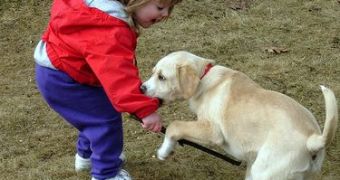A new study carried out by researchers from St George’s, University of London concluded that children whose families own a dog, are more active and in better physical shape than those without.
The research, led by Dr Christopher Owen, senior lecturer in epidemiology at St George’s, was carried out on 2,065 children aged nine to ten, whose daily movement levels were recorded over a seven-day period.
Children went to 78 schools in London, Birmingham and Leicester, and 202 of them, or nearly 10%, owned dogs.
Dr Owen said: “The more active lifestyles of children from dog-owning families is really interesting – is it that owning a dog makes you more active or that more active families choose to have a dog?
“It’s a bit of a chicken and egg question and long-term studies are needed to answer it, but it may be a bit of both.”
The research concluded that children who had dogs spent an average of 325 minutes a day doing physical activity, 11 more minutes than children without dogs.
After considering time spent in light, moderate, moderate to intense and intense activity, results showed that dog owners also spent 11 minutes less a day in sedentary behavior (from a total of 562 minutes).
Dog owners also took 360 more steps a day, four percent more than the others, AlphaGalileo reports.
Among the researchers' conclusions was that owning a dog stimulates children to be more active, which is an encouraging step against childhood obesity.
“Previous studies have compared adult activity levels before and after getting a dog, and found that they do become more active afterward,” added Dr Owen.
“This study is novel in showing that children who have a dog are more active, but, again, long term studies are needed to see if the effect is seen before and after owning a dog,” he said.
The team also found a 25% difference in the number of steps a day adults take, those who own dogs take an extra 1,700 steps on average, unlike non-dog owners.
Dr Owen specified that further work is necessary to find out how much of the dog-owning children's activity is actually made with their pet.
“If children really are going for walkies with their dog, this may be one way to encourage more kids to be active,” he said.
The research is part of the Child Heart And Health Study in England (CHASE), a St George’s project that looks at the health of 5,000 primary school children living in London and the Midlands.
The study was supported by the Wellcome Trust and its results were published in the American Journal of Public Health.

 14 DAY TRIAL //
14 DAY TRIAL //